
Panic attack symptoms are often debilitating. Do you feel like you are constantly fighting a mental state of extreme alert or panic? If so, you might be suffering from panic attacks. These episodes can be incredibly frightening and leave you feeling helpless. Living with panic attacks can be very difficult. The good news is that there are ways to help yourself.
Recognizing a Panic Attack
Separating a panic attack into its many stages and symptoms may assist in ending it. This makes it simpler to spot the beginning of a panic attack so you can stop it before it gets out of control. Understanding when a panic attack occurs is the first step in controlling one. You may experience symptoms like a racing heart, nausea, or chest pain in addition to sudden, overpowering feelings of anxiety, fear, or dread.
With their abrupt start and severe physical symptoms, panic attacks are frequently mistaken for heart attacks, strokes, or other serious medical illnesses. They may incorporate heartbeats that are rapid or palpitations (fluttering or pounding), sweating, trembling or swaying, breathing difficulty or a feeling of choking, chest discomfort, nausea, unsteadiness or faintness, and either cold or hot flashes One or more of these symptoms may indicate a panic attack, but not all of them need to be present at the same time.
In addition to physical symptoms, panic attacks can include emotional or psychological problems. They consist of apprehension, dread, gloom, feeling out of control, the fear of dying, and a sense of detachment or a lack of connection to reality. Physical symptoms may occur before, after, or concurrently with these symptoms, which might vary in intensity. When panic episodes persist over time, it may indicate the presence of a panic disorder.
(Porrey, 2022)
Methods to Regain Control During a Panic Attack
- Take deep breaths: A panic episode can be controlled by deep breathing. Rapid breathing and shallow breathing are also symptoms of panic episodes. Breathing without rhythm and mindfulness might exacerbate tension and anxious sensations. Instead, try to breathe deeply and slowly while focusing on each breath. Count to four on both the inhale and the exhale as you inhale deeply from the abdomen and fill your lungs gradually and steadily. (Medical News Today)
- Maintain Your Focus on the Here and Now: Take note of five items you can see. Next, four items you can touch. Discover three audible things. Detect two smells. You taste one thing. When you stay anchored in what’s happening around you, it offers your mind something better to do than fixate on fear or jump from one concern to the next. (Medical News Today)
- Stop the ‘What Ifs’: What-if scenarios are a major source of panic episodes. What if I’m not able to? Suppose I bump into my ex? What if I get laughed at by everyone? Accept that fear, then change your perspective from “what if” to “so what?” The worst-case situation may not always be as dreadful as it looks. (WebMD)
- Walk or engage in some modest activity: You can leave a stressful situation by walking, and the rhythm of walking may also help you control your breathing. Exercise causes the body to release endorphins, which calm the body and elevate mood. Regular exercise might help lower anxiety over time, which could decrease the frequency or intensity of panic episodes. (Medical News Today)
- Be Wary of Coffee, Alcohol, and Smoking: You can feel anxious and jittery after consuming caffeine. Moreover, it may keep you awake, which may lead to subsequent fatigue. Nicotine and alcohol might make you feel calm initially, then make you nervous as your body processes them. All three are capable of starting or intensifying panic episodes. Best to stay away from them. (WebMD)
Panic Attacks and a Visit to the ER
A panic attack can be an overwhelming experience, but it is possible to gain control over one. By understanding the warning signs and symptoms of a panic attack and developing coping skills, such as deep breathing, focusing on the present moment, stopping what-if scenarios, and engaging in light physical activity or exercise, you can significantly reduce your risk of having another attack. However, if panic episodes continue, it is important to discuss them with a healthcare provider who can help you diagnose and treat any underlying conditions that may be causing the attacks.
Some symptoms mimic heart attack or stroke which is life threatening. In this case, we want to be sure you seek emergency medical care at that time to rule out any heart problems.
Works Cited
Melissa Porrey LPC, NCC. “How to Stop a Panic Attack.” Verywell Health, Verywell Health, 10 Sept. 2022, www.verywellhealth.com/how-to-stop-a-panic-attack-5202930.
“How to Stop a Panic Attack: 13 Effective Methods.” Medical News Today, MediLexicon International, www.medicalnewstoday.com/articles/321510#methods.
“Ways to Stop a Panic Attack.” WebMD, WebMD, www.webmd.com/anxiety-panic/ss/slideshow-ways-to-stop-panic-attack.
















